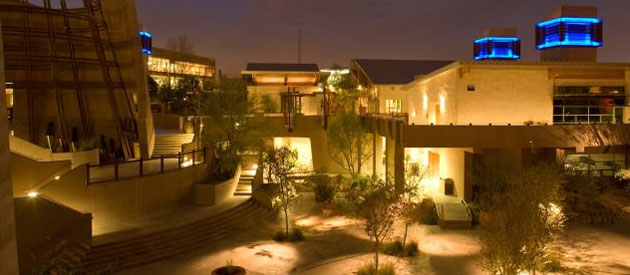Springs Preserve

Information
Springs Preserve
333 S. Valley View
Las Vegas, NV 89152
702-822-7700
website
$18.95 Adults
$17.95 Students and Seniors
$10.95 Children 5-17
Children under 5 free
Daily 9am-5pm
Vegas4Visitors Rating: A
At a Glance
What is it?
An oasis in the maddening world that is Las Vegas with an interactive museum focusing on the development of the Las Vegas valley, nature trails, ecology exhibits, gardens, a café and more.
Where is it?
A couple of miles north and west of The Strip, near the intersection Valley View Boulevard and I-95.
Is it worth the cost?
Every penny and then some for this alone but admission also includes entrance to the Nevada State Museum, so you get a bonus.
What else do I need to know?
Since a lot of the nature stuff is, unsurprisingly, outdoors, go in the morning before it gets too hot.
What’s the bottom line?
A true must-see experience.
Full Review
Tucked behind a freeway sound barrier is 180 acres of an anachronism taking physical form. It is at once the thing that you would never expect to find in Las Vegas and a thing that the city desperately needed. Part cultural center, part nature preserve, part ecological and educational facility, and part theme park the Springs Preserve needs to be on the must-see list of every Las Vegas visitor. It really is that simple: you need to go.
Located just north and west of The Strip – a quick 15 minute drive – the Preserve is located on the land that originally brought people to this area in the first place a few thousand years ago. The natural Artesian springs that once fed this otherwise arid desert landscape created a relatively verdant field of trees and greenery, eventually giving the region its name (Las Vegas is Spanish for the meadows).
It was these springs that drew people to the region, from the Mormon settlers of the 1800s to the railroad in the 1900s and the water they provided helped to develop the region.
The springs dried up in the 1960s but the land was preserved and now has been turned into a $250 million complex that aims to examine land, water, nature, the environment, and Las Vegas in a way that is both educational and entertaining.
You enter the complex through a series of canyon-like arroyos that deliver you to the front door of the centerpiece of the facility: the Origen Experience. This building contains two museum galleries, a children’s gallery, an indoor theater, and an interpretive center packed with hands-on displays and exhibits that trace the roots of how the springs helped to build Las Vegas. Recreated railroad cars and buildings from the city’s early days are interesting touches, helping to give a visual context to the multi-media centers around the space that help to explain things in a simple way.
This being Vegas, of course, there has to be some sizzle to go with the substance. One room uses high-tech visuals to make you feel like you’re a construction worker atop the 700-foot high Hoover Dam and another has the closest thing to a real-live flash flood (with thousands of gallons of water) that you’ll ever want to experience.
Beyond that building is the Desert Living Center, a collection of buildings that are all LEED Platinum Certified. This means that they have the highest rating of environmentally sensitive construction, using things like rammed earth walls instead of concrete, photo-dynamic cells for power, and natural air tunnels for cooling. Portions of the buildings are done as exhibits themselves, where you can open a panel in the wall and see the straw that was used to make it.
These buildings contain a variety of displays and facilities designed to further our understanding of the environment in general but more specifically, how we can live in desert environments without sucking up tons of water and blasting our Freon based, electric powered air conditioners all day. There are sections devoted to recycling and waste management, energy efficient living solutions, modern kitchens and bathrooms that work with the Earth instead of against it, and much more. Much of it has a definite kid appeal with plenty of hands-on (and climb through) opportunities, but adults can be just as entertained and deeply fascinated by the amazing science that goes into doing things as simple as building a better refrigerator.
A library, research and design labs, classroom and conference space, and more fill up the rest of these beautifully designed buildings.
Oh, and in case you get hungry there is also a restaurant from The Culinary Academy of Las Vegas.
But the facility does not stop there. The Commons area features an 1,800 seat outdoor amphitheater, a children’s learning playground with giant climb-on animals and soft-spongy floors, and plenty of areas to sit and relax and enjoy the surroundings.
Beyond that are the Gardens – eight acres of botanical wonder that will promote a deeper understanding of drought tolerant plants and landscaping plus offer outdoor classroom instruction areas for gardening and cooking. They even have an Enabling Garden that shows people with disabilities or physical challenges that they can still enjoy growing flowers or vegetables in their own space.
Wait, there’s more. There are more than 2.5 miles worth of walking trails and interpretive stations that trace the early settlement and development of Las Vegas with historic structures like oil derricks and archaeological sites. These trails wrap through the body of the preserve and skirt the edge of the Cienega, a recreated desert wetland that is home to hundreds of native plant, bird, and animal species.
The Boomtown 1905 section of the facility has restorations and recreations of the original buildings that existed in 1905 when the city was founded, including a train station and railroad cottages.
And as if all that weren’t enough, the campus also includes the Nevada State Museum, which chronicles the history of the region from ancient times to the casino era and entrance to that is included in the admission free for the Springs Preserve.
I’m not much of an outdoors kind of person and the closest I get to environmental awareness is insisting that one of these days I’m going to rent “An Inconvenient Truth” and be morally outraged about the whole thing. But this facility goes way beyond politics or preaching or even the kind of bland educational malaise that seems to grip things like natural history museums. It simply exists as a testament to what we have done and what we can do, not to necessarily tell us what we should do.
I found the whole thing fascinating – both stimulating and calming in turns. Standing there looking out across the desert landscape with the towering, glittering Strip just a few miles away as a backdrop, was the kind of sight that can give you some much needed perspective. It is a perfect antidote to the over-processed experience that Las Vegas has become.
To get there you’ll need a car, a taxi or a bus since it’s close to The Strip but not within walking distance. If you’re driving yourself take any of the major East-West streets like Sahara, Flamingo, or Tropicana to Valley View and hang a right. The Springs Preserve is at the corner of Valley View and Alta Drive, near the Meadows Mall and Interstate 95. A taxi from The Strip will probably run you in the $15-$20 range depending on what part you’re traveling from.
